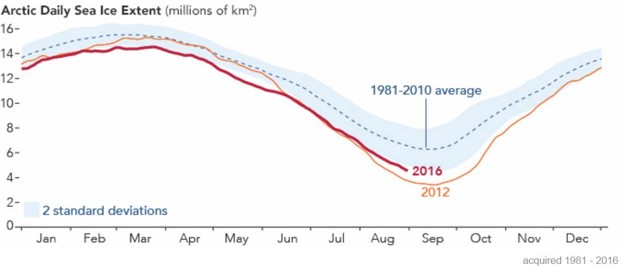Watch the Grim, Ongoing Loss of the Arctic's Historical Ice
According to NASA, the Arctic had 1.2 million square miles of old ice in the 1980s. Today it has just 68,350.
The Arctic’s sea ice has been diminishing so much there’s a good likelihood in future summers the region will be completely liquid, allowing the ocean to absorb more sunlight and accelerate global warming. While 2016 hasn’t been the worst year, it’s certainly close to the record lowest-extent for sea ice (in 2012):
But as NASA points out in a new visualization, not all melting is equal. Whereas the warming climate had previously attacked seasonal ice, which accumulates and melts away in relatively short periods, it’s now corroding the Arctic’s precious stores of long-term ice. The agency writes :
“What we’ve seen over the years is that the older ice is disappearing,” said Walt Meier, a sea ice researcher at NASA’s Goddard Space Flight Center. “This older, thicker ice is like the bulwark of sea ice: a warm summer will melt all the young, thin ice away but it can’t completely get rid of the older ice. That bulwark is not as good as it used to be. The older ice is becoming weaker because there is less of it, and the remaining ice is more broken up and thinner.”...
“We have lost most of the older ice: In the 1980s, multiyear ice made up 20 percent of the sea ice cover; now it’s only about 3 percent,” Meier added. “The older ice was like the insurance policy of the Arctic sea ice pack. As we lose it, the likelihood for a largely ice-free summer in the Arctic increases.”
You can watch the older ice disappear from the 1980s to 2016 in this animation based on data from satellites, buoys, weather stations, and computer models. Younger ice is darker while multiyear ice is white; consider that there were 1.2 million square miles of ice aged 5 years or more in 1984, whereas this September there were just 68,350.




